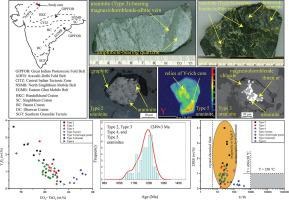当前位置:
X-MOL 学术
›
Ore Geol. Rev.
›
论文详情
Our official English website, www.x-mol.net, welcomes your feedback! (Note: you will need to create a separate account there.)
Geochemical evolution and timing of uranium mineralization in the Khetri Copper Belt, western India
Ore Geology Reviews ( IF 3.3 ) Pub Date : 2020-12-01 , DOI: 10.1016/j.oregeorev.2020.103794 Abu Saeed Baidya , Dipak C Pal
Ore Geology Reviews ( IF 3.3 ) Pub Date : 2020-12-01 , DOI: 10.1016/j.oregeorev.2020.103794 Abu Saeed Baidya , Dipak C Pal

|
Abstract The Khetri Copper Belt (KCB), located in the northwestern part of the Aravalli-Delhi Fold Belt, western India, is famous for Cu mineralization and known for Au ± Ag ± Co ± Fe ± REE ± U ± P occurrences. The present study conducted in and around the Madan-Kudan-Kolihan-Chandmari Cu deposits of the KCB integrates the mode of occurrence, mineralogical association, textural relation, and chemistry of hydrothermal minerals, and in situ chemical dating of uraninite. We propose that the U mineralization, represented by Type 1 to Type 6 uraninites, has evolved through six successive stages: U-mineralization (Type 1 uraninite) of uncertain origin → U-mineralization (Type 2 uraninite) during Fe-Mg alteration → U-mineralization (Type 3 uraninite) during Ca-Na alteration → Cu-Fe-Co-REE-U mineralization (Type 4 uraninite) during Na-Ca-K alteration → U-mineralization (Type 5 uraninite) during chloritization (Fe-Mg alteration) → Cu-Co-REE-U mineralization (Type 6 uraninite) during K-Fe-Mg alteration. The chemical ages of uraninite suggest that the hydrothermal mineralization associated with Type 2 to Type 5 uraninites formed during a hitherto unknown older event (compared to the previously reported age of the mineralization in the KCB i.e. ~ 850 Ma), which initiated during the second phase of metamorphism of ~ 1.40–1.30 Ga (M2) and terminated well before the third phase of metamorphism of ~ 985–920 Ma (M3). The K-Fe-Mg alteration and the associated mineralization most likely is time-equivalent of the known alteration-mineralization event of ~ 850 Ga. The chlorite and biotite thermometry in tandem with U/Th ratios of uraninite suggest that uraninites crystallized at high temperature (> 390 °C) in all the hydrothermal stages. The common presence of magnetite and ilmenite, the occasional presence of graphite, and the Fe3+/(Fe3++Fe2+) ratios of the co-genetic gangue minerals such as amphibole, biotite, and chlorite suggest reduced environment, below the haematite-magnetite buffer, during the crystallization of uraninite in all the hydrothermal stages. Based on the composition of gangue minerals (apatite, amphibole, biotite, chlorite, and scapolite) in alteration assemblages/veins and physicochemical characters of the fluids, we discuss the possibility of transportation of U as U4+-chloride and -fluoride complexes. The high temperature and reduced nature of the fluids, high Th contents and low U/Th ratios of most of the uraninites, similar age of mineralization (Type 2 to Type 5 uraninite) and M2 metamorphism, and the absence of concomitant magmatic activity collectively suggest that hydrothermal mineralization related to Type 2 to Type 5 uraninites took place from metamorphic fluids. We report, for the first time, a unique uraninite-graphite association in the KCB, which can be best explained by their co-precipitation from a hydrothermal fluid during the earliest Fe-Mg alteration.
中文翻译:

印度西部 Khetri 铜矿带铀矿化的地球化学演化和时间
摘要 Khetri铜矿带(KCB)位于印度西部Aravalli-Delhi褶皱带西北部,以铜矿化着称,以Au±Ag±Co±Fe±REE±U±P矿床着称。目前在 KCB 的 Madan-Kudan-Kolihan-Chandmari 铜矿床及其周围进行的研究综合了热液矿物的赋存方式、矿物学关联、构造关系和化学性质,以及铀矿的原位化学定年。我们认为以 1 型到 6 型铀矿为代表的 U 矿化经历了六个连续的阶段:成因不明的U-矿化(1型铀矿)→Fe-Mg蚀变U-矿化(2型铀矿)→Ca-Na蚀变U-矿化(3型铀矿)→Cu-Fe-Co-REE-U矿化Na-Ca-K蚀变期间(4型铀矿)→绿泥石化(Fe-Mg蚀变)U-矿化(5型铀矿)→K-Fe-Mg蚀变Cu-Co-REE-U矿化(6型铀矿) . 铀矿的化学年龄表明,与 2 型至 5 型铀矿相关的热液矿化形成于迄今为止未知的更古老事件(与之前报道的 KCB 矿化年龄相比,即~850 Ma)期间,该事件始于第二阶段~ 1.40–1.30 Ga (M2) 的变质作用,并在 ~ 985–920 Ma (M3) 变质作用的第三阶段之前终止。K-Fe-Mg 蚀变和相关矿化最有可能与已知的约 850 Ga 蚀变-矿化事件在时间上等价。绿泥石和黑云母温度测量与铀矿的 U/Th 比值表明,铀矿在高温下结晶(> 390 °C) 在所有热液阶段。磁铁矿和钛铁矿的共同存在、石墨的偶尔存在以及共生脉石矿物(如角闪石、黑云母和绿泥石)的 Fe3+/(Fe3++Fe2+) 比率表明赤铁矿-磁铁矿缓冲层下方的环境减少, 在所有热液阶段的铀矿结晶过程中。根据蚀变组合/脉中脉石矿物(磷灰石、角闪石、黑云母、绿泥石和方柱石)的组成和流体的理化特征,我们讨论了 U 以 U4+-氯化物和 -氟化物复合物形式运输的可能性。流体的高温和还原性质、大多数铀矿的高 Th 含量和低 U/Th 比、相似的成矿年龄(2 型至 5 型铀矿)和 M2 变质作用以及不存在伴随的岩浆活动共同表明与 2 型至 5 型铀矿相关的热液矿化发生在变质流体中。我们首次报告了 KCB 中独特的铀矿-石墨组合,这可以通过它们在最早的 Fe-Mg 蚀变期间从热液流体中的共沉淀来最好地解释。相似的成矿年龄(2 型至 5 型铀矿)和 M2 变质作用,以及没有伴随的岩浆活动,共同表明与 2 型至 5 型铀矿相关的热液矿化发生在变质流体中。我们首次报告了 KCB 中独特的铀矿-石墨组合,这可以通过它们在最早的 Fe-Mg 蚀变期间从热液流体中的共沉淀来最好地解释。相似的成矿年龄(2 型至 5 型铀矿)和 M2 变质作用,以及没有伴随的岩浆活动,共同表明与 2 型至 5 型铀矿相关的热液矿化发生在变质流体中。我们首次报告了 KCB 中独特的铀矿-石墨组合,这可以通过它们在最早的 Fe-Mg 蚀变期间从热液流体中的共沉淀来最好地解释。
更新日期:2020-12-01
中文翻译:

印度西部 Khetri 铜矿带铀矿化的地球化学演化和时间
摘要 Khetri铜矿带(KCB)位于印度西部Aravalli-Delhi褶皱带西北部,以铜矿化着称,以Au±Ag±Co±Fe±REE±U±P矿床着称。目前在 KCB 的 Madan-Kudan-Kolihan-Chandmari 铜矿床及其周围进行的研究综合了热液矿物的赋存方式、矿物学关联、构造关系和化学性质,以及铀矿的原位化学定年。我们认为以 1 型到 6 型铀矿为代表的 U 矿化经历了六个连续的阶段:成因不明的U-矿化(1型铀矿)→Fe-Mg蚀变U-矿化(2型铀矿)→Ca-Na蚀变U-矿化(3型铀矿)→Cu-Fe-Co-REE-U矿化Na-Ca-K蚀变期间(4型铀矿)→绿泥石化(Fe-Mg蚀变)U-矿化(5型铀矿)→K-Fe-Mg蚀变Cu-Co-REE-U矿化(6型铀矿) . 铀矿的化学年龄表明,与 2 型至 5 型铀矿相关的热液矿化形成于迄今为止未知的更古老事件(与之前报道的 KCB 矿化年龄相比,即~850 Ma)期间,该事件始于第二阶段~ 1.40–1.30 Ga (M2) 的变质作用,并在 ~ 985–920 Ma (M3) 变质作用的第三阶段之前终止。K-Fe-Mg 蚀变和相关矿化最有可能与已知的约 850 Ga 蚀变-矿化事件在时间上等价。绿泥石和黑云母温度测量与铀矿的 U/Th 比值表明,铀矿在高温下结晶(> 390 °C) 在所有热液阶段。磁铁矿和钛铁矿的共同存在、石墨的偶尔存在以及共生脉石矿物(如角闪石、黑云母和绿泥石)的 Fe3+/(Fe3++Fe2+) 比率表明赤铁矿-磁铁矿缓冲层下方的环境减少, 在所有热液阶段的铀矿结晶过程中。根据蚀变组合/脉中脉石矿物(磷灰石、角闪石、黑云母、绿泥石和方柱石)的组成和流体的理化特征,我们讨论了 U 以 U4+-氯化物和 -氟化物复合物形式运输的可能性。流体的高温和还原性质、大多数铀矿的高 Th 含量和低 U/Th 比、相似的成矿年龄(2 型至 5 型铀矿)和 M2 变质作用以及不存在伴随的岩浆活动共同表明与 2 型至 5 型铀矿相关的热液矿化发生在变质流体中。我们首次报告了 KCB 中独特的铀矿-石墨组合,这可以通过它们在最早的 Fe-Mg 蚀变期间从热液流体中的共沉淀来最好地解释。相似的成矿年龄(2 型至 5 型铀矿)和 M2 变质作用,以及没有伴随的岩浆活动,共同表明与 2 型至 5 型铀矿相关的热液矿化发生在变质流体中。我们首次报告了 KCB 中独特的铀矿-石墨组合,这可以通过它们在最早的 Fe-Mg 蚀变期间从热液流体中的共沉淀来最好地解释。相似的成矿年龄(2 型至 5 型铀矿)和 M2 变质作用,以及没有伴随的岩浆活动,共同表明与 2 型至 5 型铀矿相关的热液矿化发生在变质流体中。我们首次报告了 KCB 中独特的铀矿-石墨组合,这可以通过它们在最早的 Fe-Mg 蚀变期间从热液流体中的共沉淀来最好地解释。


























 京公网安备 11010802027423号
京公网安备 11010802027423号